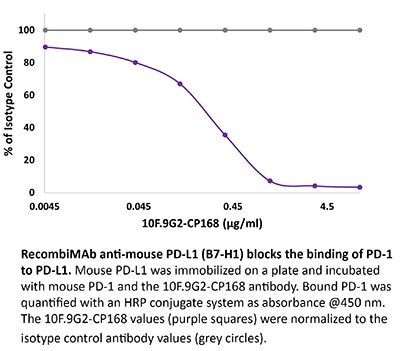Catalog #CP168
RecombiMAb anti-mouse PD-L1 (B7-H1)
Clone
10F.9G2™-CP168
Reactivities
Mouse
Product Citations
1
Isotype
Mouse IgG1
(switched from rat IgG2b)
(switched from rat IgG2b)
You may also be interested in:
Product Description
The 10F.9G2™-CP168 monoclonal antibody is a recombinant chimeric version of the original 10F.9G2™ antibody. The variable domain sequences are identical to the original 10F.9G2™ but the constant region sequences have been switched from rat IgG2b to mouse IgG1. The 10F.9G2™-CP168 antibody contains no Fc mutations just as the original rat IgG2b antibody does not. The 10F.9G2™-CP168 antibody reacts with mouse PD-L1 (programmed death ligand 1) also known as B7-H1 or CD274. PD-L1 is a 40 kDa type I transmembrane protein that belongs to the B7 family of the Ig superfamily. PD-L1 is expressed on T lymphocytes, B lymphocytes, NK cells, dendritic cells, as well as IFNγ stimulated monocytes, epithelial cells and endothelial cells. PD-L1 binds to its receptor, PD-1, found on CD4 and CD8 thymocytes as well as activated T and B lymphocytes and myeloid cells. Engagement of PD-L1 with PD-1 leads to inhibition of TCR-mediated T cell proliferation and cytokine production. PD-L1 is thought to play an important role in tumor immune evasion. Induced PD-L1 expression is common in many tumors and results in increased resistance of tumor cells to CD8 T cell mediated lysis. In mouse models of melanoma, tumor growth can be transiently arrested via treatment with antibodies which block the interaction between PD-L1 and PD-1. The 10F.9G2™ antibody has been shown to block the interaction between PD-L1 and PD-1 and between PD-L1 and B7-1 (CD80).
Specifications
| Isotype | Mouse IgG1, κ |
|---|---|
| Recommended Isotype Control(s) | RecombiMAb mouse IgG1 isotype control, anti-hen egg lysozyme |
| Recommended Dilution Buffer | InVivoPure pH 7.0 Dilution Buffer |
| Conjugation | This product is unconjugated. Conjugation is available via our Antibody Conjugation Services. |
| Immunogen | Mouse CD274 |
| Reported Applications |
in vivo PD-L1 blockade* Immunofluorescence* Immunohistochemistry (frozen)* Flow cytometry* Western blot* *Reported for the original rat IgG2a RMP1-14 antibody |
| Formulation |
PBS, pH 7.0 Contains no stabilizers or preservatives |
| Endotoxin |
≤0.5EU/mg (≤0.0005EU/μg) Determined by LAL assay |
| Aggregation |
<5% Determined by SEC |
| Purity |
≥95% Determined by SDS-PAGE |
| Sterility | 0.2 µm filtration |
| Production | Purified from CHO cell supernatant in an animal-free facility |
| Purification | Protein A |
| RRID | AB_2927530 |
| Molecular Weight | 150 kDa |
| Murine Pathogen Tests |
Ectromelia/Mousepox Virus: Negative Hantavirus: Negative K Virus: Negative Lactate Dehydrogenase-Elevating Virus: Negative Lymphocytic Choriomeningitis virus: Negative Mouse Adenovirus: Negative Mouse Cytomegalovirus: Negative Mouse Hepatitis Virus: Negative Mouse Minute Virus: Negative Mouse Norovirus: Negative Mouse Parvovirus: Negative Mouse Rotavirus: Negative Mycoplasma Pulmonis: Negative Pneumonia Virus of Mice: Negative Polyoma Virus: Negative Reovirus Screen: Negative Sendai Virus: Negative Theiler’s Murine Encephalomyelitis: Negative |
| Storage | The antibody solution should be stored at the stock concentration at 4°C. Do not freeze. |
| Need a Custom Formulation? | See All Antibody Customization Options |
Product Citations
-
-
Mus musculus (Mouse)
-
Immunology and Microbiology
High PD-1 and CTLA-4 expression correlates with host immune suppression in patients and a mouse model infected with Echinococcus multilocularis.
In Parasit Vectors on 25 October 2024 by Sun, T., Yang, Y., et al.
PubMed
Alveolar echinococcosis (AE), a fatal disease caused by Echinococcus multilocularis, often affects the liver, with tumor-like growth. However, the mechanism by which E. multilocularis evades host immune surveillance remains unclear.
-
View More

